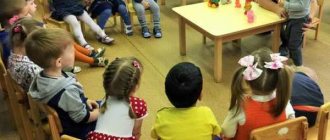Structure of the lesson - conversation
Material according to MDK.03.02.
“Theory and Methods of Speech Development in Children” is intended for 4th year students
Part-time specialty training
Preschool education.
Teacher: Yushmanova E.G.
- Conversation is a method of developing dialogical speech.
- The meaning of conversation.
- Classification of conversations.
- Preparing for a conversation between the teacher and children.
- Structure of the conversation.
- Teaching techniques.
A conversation is a purposeful discussion of something, an organized, prepared dialogue on a pre-selected topic. Conversation is considered as a method of getting to know the environment and as a method of developing coherent speech.
Conversation is an active method of mental education. The question-and-answer nature of communication encourages the child to compare, reason, and generalize.
In conversation, together with thinking, speech develops: coherent logical statements, value judgments, figurative expressions. Dialogue and monologue speech is formed. Children learn evidence-based speech, the ability to justify their point of view, and enter into a “discussion.”
In the conversation, children’s vocabulary is activated, clarified and replenished, because The teacher encourages the children to look for the most accurate words for the answer.
Conversations also have educational value. Many topics of conversation influence the behavior of children, their actions (Why can’t we speak loudly on the bus? How can we please the kids?) Conversation helps to form a positive attitude towards people, the country, hometown, and loved ones.
Conversation is also important for aesthetic education. The child learns to listen carefully to the person who is speaking and to restrain the desire to answer a question without waiting for a call. Consequently, restraint, politeness and, in general, a culture of verbal communication are cultivated.
Classification of conversations.
Professor Evgenia Aleksandrovna Flerina classified the conversations based on didactic objectives:
1. An introductory conversation that precedes the acquisition of new knowledge is the connecting link between the experience children have and the one they will acquire. The goal is to find out what children know about this topic and to create interest in the upcoming activity. These conversations are successful if they are short, emotional, conducted in a relaxed atmosphere, a number of questions remain unresolved (“We’ll see... We’ll see... We’ll check...”).
2. Conversation accompanying the activities and observations of children (Conversation accompanying the acquisition of new experience). It is carried out in the process of children's activities, excursions, observations and unites children with common interests and collective statements. The goal is to stimulate and direct children's attention to a richer accumulation of experience. Children, observing, express their thoughts in the form of individual remarks and individual words. An exchange of views takes place. During the conversation, the teacher’s word plays an explanatory role, revealing the content of the material that children perceive.
3. Generalizing conversation. The goal is to systematize, clarify and expand the experience (knowledge) of children gained in the process of their activities, observations, and excursions. Generalizing conversation is a lesson held 1-2 times a month.
Other methodologists add conversations on works of art and conversations on paintings to these types.
In terms of content, we can roughly distinguish conversations of an educational nature (about school, about one’s hometown) and ethical ones (about the norms and rules of behavior of people in society and at home).
The teacher’s preparation for the conversation is as follows:
A) choosing the topic of conversation;
B) determination of program content and educational objectives;
C) drawing up a plan for the conversation (micro-topics);
D) selection of illustrative material.
Preparing children for a conversation consists of drawing the children’s attention a few days before the lesson to the objects and phenomena that will be discussed, naming them in words, letting them look at them, recognizing their signs, i.e. the factual material of the conversation should already be familiar to the children. The best preparation method is a preliminary conversation on the same or a similar topic, perhaps a tour, observation, or reading fiction. The preparatory work is indicated in the outline.
The content of the conversations is program material to familiarize children with the life around them: the life and work of people, events in public life, the activities of children in kindergarten (games, work, mutual assistance, friends).
The topics of the conversations are determined by the objectives of educational work with children, their age characteristics, the stock of knowledge acquired during excursions and observations, as well as their immediate environment. For example,
— natural history topics (introduced from the middle group):
Our park in spring. Wintering and migratory birds.
— topics reflecting phenomena of social life:
Moscow is the capital of our Motherland. Holidays (New Year, Maslenitsa, May 9, etc.)
- moral and ethical: (conducted from the senior group)
Conversation about friendship. Who can be called an honest person. Respect the work of your elders.
It is possible to systematize knowledge in a conversation provided that the material is arranged sequentially.
Structure of the lesson - conversation
I. Beginning of the conversation (introductory).
Goal: to attract children’s attention to the topic of conversation, to revive previously received impressions.
You can start a conversation with a memory, riddle, poem, showing a painting, photograph, object. A conversation about autumn can begin with the question: “Why is autumn called golden?” Conversation “On the culture of behavior” with the problematic question: “What kind of person can be said to be a cultured person?”
At the beginning of the conversation, it is advisable to formulate the topic (goal) of the upcoming conversation and justify its importance.
II. Main part.
In the main part of the conversation, during the analysis of phenomena, its content is revealed. To this end, children are consistently asked questions that activate their thinking and speech activity. The teacher gives explanations, confirms the children's answers, generalizes them, makes additions and amendments. Children are given new information in order to clarify or deepen knowledge about the essence of a phenomenon, about objects, etc. The success of the conversation is ensured by the emotionality of its conduct, the use of poetry, riddles, visual material, the participation and activity of all children in the group.
The main part is divided into micro-topics. Each micro-topic solves a particular problem. For example, the general goal of the conversation “About Health” in the senior group: to consolidate knowledge about those conditions that help maintain good health.
We highlight 4 microthemes:
1. Fresh air (indoors, while walking). Particular task: to clarify knowledge about the positive effects of fresh air on health.
2. Morning exercises, the need for a variety of exercises.
Particular task: to clarify knowledge about the positive effects of morning exercises on health, etc.
III. The end of the conversation is short in time.
Most often these are generalizing conclusions throughout the conversation. An ethical conversation can be completed by setting the following rule: “Polite people, when entering, are the first to greet everyone, bow their heads, and smile. Polite children will never forget to say hello first. Always remember this."
The conversation can be ended with a riddle, poem, proverb, music related to the topic of the conversation.
You can invite children to watch birds, hang a feeder for wintering birds, or draw a picture as a gift for their mother.






